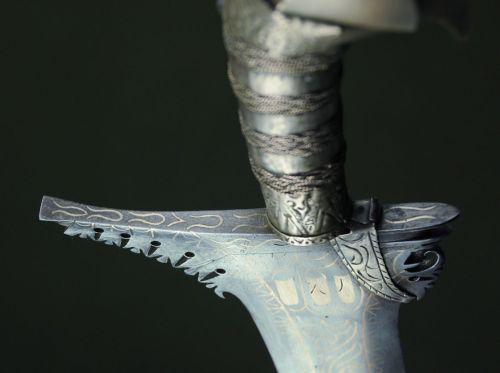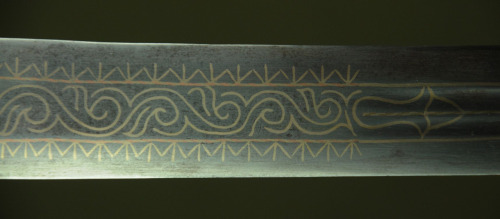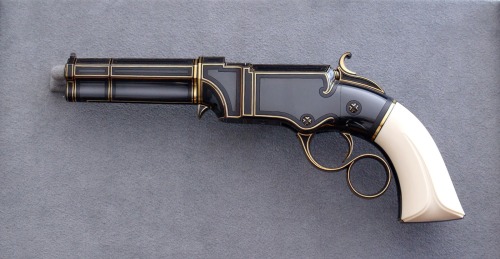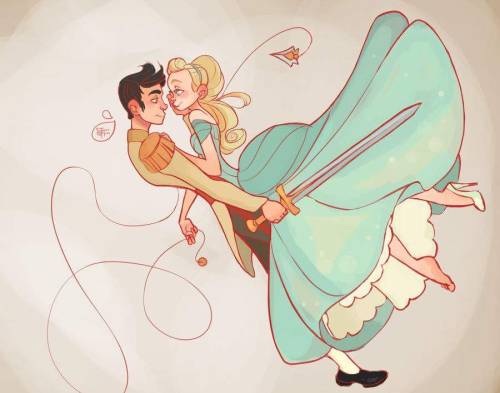Your gateway to endless inspiration
Weapon - Blog Posts









Khanjar Dagger
Dated: circa 1800
Culture: Indian, Moghul
Measurements: overall length 38.3 cm
The dagger has a lightly-curved, double-edged blade with a slightly strengthened tip. The grip is sculpted in one piece of jade or agate in shades from yellow to beige, provided with a guard. The upper part of the quilt features a gold lion two rubies for the eyes and an emerald on the head. The wooden scabbard is covered in red and gold cloth and silver mounts engraved with floral motifs and partially pierced.
Source: Copyright © 2016 Czerny’s International Auction House S.R.L.






Small Dagger
Dated: 19th century
Culture: Russian
Measurements: overall lenght 30cm
The dagger features a straight, double-edged blade with a central groove and golden decorations. The steel hilt is decorated en suite, the white horn grip having oblique, golden staves. The steel scabbard is also decorated en suite.
Source: Copyright © 2016 Czerny’s International Auction House S.R.L.








Rapier with Scabbard
Dated: 1575-1583
Geography: made in Dresden, Saxony, Germany, Europe
Medium: engraved steel [blade]; blackened iron, pierced and engraved silver, wood, silver wire [hilt]; pierced and engraved silver, wood, leather [scabbard]
Measurements: pommel: 2 ½ × 2 13/16 inches (6.3 × 7.1 cm); blade: 11/16 × 42 3/8 inches (1.8 × 107.6 cm); width (quillons): 9 15/16 inches (25.2 cm); depth: 5 13/16 inches (14.8 cm); scabbard: 2 ½ inches × 7/8 inches × 3 feet 2 ½ inches, 8.1 ounces (6.4 × 2.3 × 97.8 cm, 230g)
The blade of the sword was made by bladesmith Andrea Ferrara, Italian (active Belluno), active 1550 - 1583. The sword features silver mounts of rapier and scabbard probably by silversmith Wendel unter den Linden, German (active Dresden), active 1566 - 1593, died before 1610.
Source: Copyright © 2016 Philadelphia Museum of Art







Imperial Guard Officer Horse Grenadier Sword
Dated: 1811
Maker: Lefevbre Paris
Culture: French
Measurements: overall length 1.17m; weight 1.964kg; weight without scabbard 1.28kg
The sword features a brass and leather scabbard similar to the second model for the Horse Grenadier troop sword. This particular model could have also belonged to the Empress’s Dragoons or to an officer of the Cuirassiers since the steel blade is straight and not curved. In any case it did belong to an Heavy Cavalry Officer from Napoléon Army. It is marked with the manufacturer’s name “Lefevbre Paris”, while the scabbard tip is marked "ND”.
Source: Copyright © 2016 Sword Collection





Handmade Swords - Earil
By Peter Lyon of Weta Workshop
Edition Size: 1
Measurements: blade length 915mm (36"); overall length 1217mm (48"); weight 1.94Kg (4 pounds 4 ounces); balance point 71mm (2.8") along the blade, measured from the shoulder of the blade
The sword has been made especially for the Weta Cave and Weta’s Online Shop to sell to the public. It is similar to late medieval European longswords, but with design flourishes transform it into a piece of art as well. A longsword is light enough and balanced to be used with one hand, but it can also be used two handed for powerful cutting blows. The blade is broad for much of its length, making for strong cuts, but comes to an acute point for effective thrusts, making this a true cut-and-thrust sword.
The individual parts have shapes and detail lines that blend into each other and continue into the next component, so that shapes continue even as the materials change, and the shapes of all the hilt parts draw the eye towards the diamond shaped bosses in the centre of the grip, filled with polished Paua (New Zealand abalone) shell each side. At the same time there is a strong central line through the hilt and along the blade, emphasising the straight and symmetrical shapes of the sword.
This sword has many nautical features which led me to the name, “Aearil”, which in Elvish means “Gleaming Ocean”.
The straight blade is ground from spring steel bar, and has been heat treated to give the best possible combination of toughness and edge hardness. Historically blades were forged into shape and to remove flaws in the steel, but the consistency and high specifications of modern steels mean this is no longer necessary.
The bevelled edge is blunted for safety and display, but could just as easily be sharpened for cutting tests. The tang of the blade is strong and wide, and passes through the cross guard, grip and pommel, and is peened over the end of the pommel for maximum strength.
The cross guard is cut from a block of mild steel. From the centre block it projects along the blade and towards the ends, which are split into a fork. This is an unusual feature which I don’t recall being used on a sword before. The cross is set onto the shoulders of the blade for extra strength and stability, as was done on medieval European swords to prevent the cross becoming loose and rattling through use.
The grip is made of beech wood, covered with leather. Thin cords under the leather create the designs, and the leather has been carefully tooled to fit into all the shapes created by the cords. The grip was mostly drilled out then fitted by heating the tang and burning out the remaining wood for a tight fit, and finally glued in place. It is a two handed grip; the foregrip is straight to give a strong gripping surface, while the waisted shape of the upper grip encourages the second hand to nestle into the inside curves of the pommel.
The mild steel pommel is also a counterweight for the blade. It is shaped somewhat like a fish tail, with curved and recessed faces to add interesting shapes, and also to remove weight and get the best possible balance for the sword overall. The pommel was set tight onto the tapering tang before the end was peened over.
Source: Copyright © 2016 Weta Ltd.

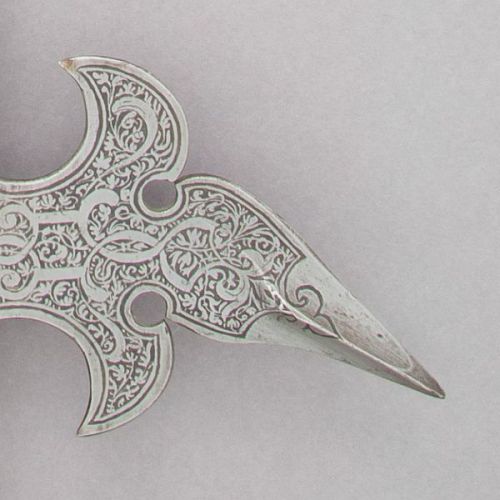

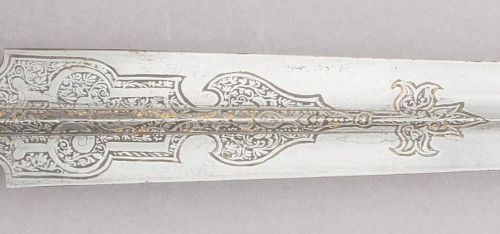

Halberd of the Guard of the Electors of Saxony
Dated: circa 1620
Geography: Saxony
Culture: Saxon
Medium: steel, wood, gold, textile, metallic thread
Dimensions: L. 8 ft. 8 ½ in. (265.4 cm); L. of head 50 ½ in. (128.3 cm); W. 11 ½ in. (29.2 cm); Wt. 7 lbs. 2.2 oz. (3237.5 g)
Source: Copyright © 2015 The Metropolitan Museum of Art




Hunting Sword of Prince Camillo Borghese
Swordsmith: François Pirmet (French, Paris, recorded 1779–1818)
Goldsmith: Antoine-Modeste Fournera (French, Paris, documented 1806–17)
Dated: 1809–13
Culture: French, Paris
Medium: Silver-gilt, steel, leather, mother-of-pearl
Measurements: Weight with scabbard, 1 lb. 10 oz. (737 g) Length with scabbard, 27 in. (68.58 cm) Length of sword, 25 7/16 in. (64.59 cm) Length of blade, 19 ¾ in. (50.17 cm) Length of scabbard, 21 3/8 in. (54.28 cm) Greatest width of hilt, 4 5/8 in. (11.73 cm) Greatest width of blade, 1 3/16 in. (3 cm)
Provenance: Ex. Coll.: Borghese, Rome; Frederick Gallatin; Albert Gallatin; James P. Gallatin
In addition to the traditional hunting motifs, the decoration includes (on the back of the guard) the monogram of Camillo Borghese (1775–1832), Napoléon’s brother-in-law, who served the French cause in Italy. The scabbard is engraved with Pirmet’s name and his title, “gunmaker to His Majesty, the King of Westphalia,” in reference to Napoleon’s brother Jérôme Bonaparte.
Source: © 2000–2013 The Metropolitan Museum of Art







Weapons!
Its good to be able to visualize some of our closest companions. Also, I’m guessing not everyone knows what a guisarme is.
First 3 images are from the Pathfinder Core Rule Book and Advance Player’s Guide, owned by Paizo.
Last four images are from the D&D 3.5 Player’s Handbook, and owned by Wizards of the Coast.
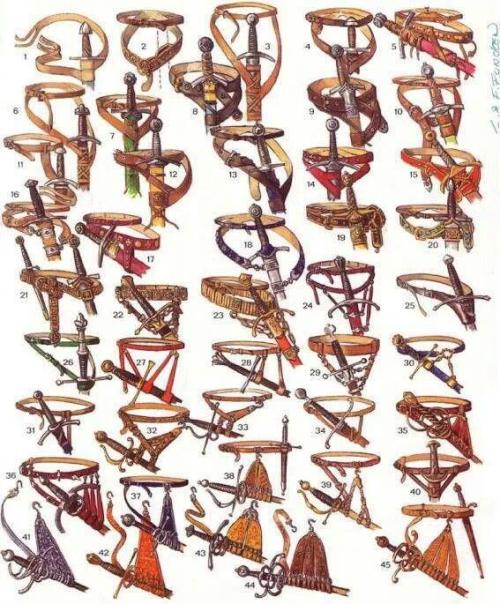
@History_Pics: Different ways to hang your sword. http://pic.twitter.com/3966S3BAzo
Odd question. But can you post a closeup on your personal preference on how to hold a knocked arrow when you draw?
As you can see in a lot of my pictures, I prefer the Mediterranean Draw, even though I shoot a Mongolian Horsebow as well as the English Longbow. The reason for this is simply that I was taught the Mediterranean Draw when I first picked up archery and I just stuck with it. It is what works best for me!




I hope this was helpful :)

Art for clothoverlord and dsarvess on FA. Two warrior princesses preparing to clear another dungeon.






